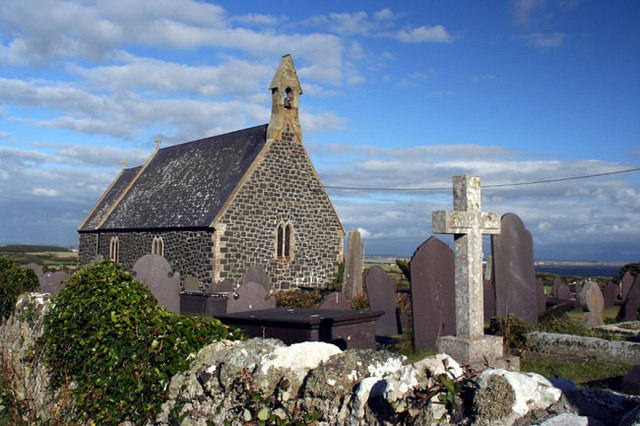Rhoscolyn in the south-west corner of Holy Island gets its name, meaning 'the moor of the column', from a column erected by the Romans - one of many such columns which were put up to commemorate victories and to mark the boundaries of the Romans' conquered territories. To the west of the village is Rhoscolyn Head, with St Gwenfaen's Well, the remains of a probably medieval dry stone well house which lies near the cliff top next to the coastal path. Back in the village St Gwenfaen, who was the daughter of Pawl Hen of Manaw (Isle of Man), also lends her name to the village church, a simple grey stone structure on an elevated patch of ground with spectacular views. The present-day church dates from around 1870 and incorporates some features from an earlier 15th century church which succumbed to a fire, although originally there was a church built here as early as the 6th century.
The coast around Rhoscolyn is characterised by rocky headlands and small bays, chiefly Borthwen, a tiny bay with a curved beach backed by dunes, and Silver Bay. These two bays are popular with sea kayakers and other watersports practitioners and there are rock pools to explore. Just offshore is Ynysoedd Gwylanod (Gull's Island), which is topped by a navigational beacon erected after the Borthwen lifeboat station was closed. As elsewhere in Anglesey, the brave lifeboatmen of Rhoscolyn were called upon to help out many a ship in distress. One such was the Timbo, a steamship which got into trouble in seas so treacherous that the lifeboat crew, after several valiant attempts to come to the aid of the Timbo, were forced to turn back. Sadly the lifeboat capsized and five of the crew members died, along with four of the Timbo's men. There is a memorial to the five lifeboatmen who lost their lives in Rhoscolyn churchyard.
Map of the area.
 | |
| The cemetery and Church - geograph.org.uk - 1040479. Photo by Bob Shires, via Wikimedia Commons. |
No comments:
Post a Comment